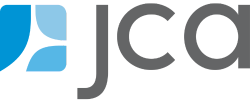The Reopening Playbook: Audience Segmentation
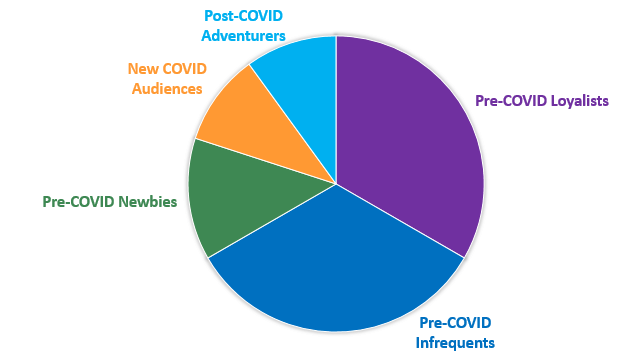
Jamie Alexander
Vice President, Growth and Development
Let’s take a moment to relish in the fact that returning to the theatre to watch a show with a fabulous group of strangers is ACTUALLY. ON. THE. HORIZON!! There’s more hope in the air now than in all of the past 16 months combined. As everyone rushes to get shows back on their feet and audiences in theatres, let’s not forget that.
But there is a feeling of frenzy. With creative and non-traditional 2021-22 seasons to sell, we’ve all been scrambling to answer the main question—how do we make sure we’ve learned from this time and get our audiences, new and old, back in through our doors?
It’s a gigantic question, and we’re here to help you organize and prioritize your marketing efforts as you prepare for to meet this challenge. To do this, we’ve created a framework called “the Reopening Playbook.”
THE PLAYBOOK FRAMEWORK
In team sports, a playbook is used to plan for the unknowns. Strategies are laid out in advance to make decision making in the moment faster and more efficient. In the case of a sports team, the primary unknown is: what the other team is going to do. For us, the primary unknown is: how audiences will behave in the first in-person season post-pandemic.
And thus, we’ve created the Reopening Playbook framework to help you prepare your strategies so your decision-making becomes easier during the season. The playbook will help you make sure that you are well positioned to reengage your audiences (through segmentation) and recoup revenue (through revenue management) as you invite people back into your space.

We hosted a webinar last month to walk through our Playbook framework in totality, and in this blog post we’re focusing on the aspects of the playbook involving segmentation.
THE STARTING FORMATION: SEGMENTATION DEFINITIONS & GOALS
Before we draft our Reopening Playbook, we first have to set our starting formation. This includes defining our audience segments and goals. Other vital pieces of the starting formation are ticket prices and forecasting, but we’ll get to those in another blog post.
Segmentation is a Customer Relationship Management practice that helps you focus your marketing efforts so they have the largest impact possible. You may have a segmentation model in place (most common is based on Recency, Frequency, and Value), but for reopening you’ll want to use a new segmentation to focus your engagement efforts. Here’s what it might look like:

For each of these segments, you’ll want to define the segment, set a 2021-22 goal for the segment, and outline tactics to reach that goal. Here’s an example of a starting formation for the “Pre-COVID Loyalists.”

If you’re on Tessitura, the Segmentation Engine can easily help you segment your audience into a COVID Segmentation and measure progress toward your goals (ask us how).
BUILDING THE PLAYBOOK: SEGMENT PLAYS
Once you’ve set your starting formation, the next step is to create your in-season plan. We don’t know how each segment will actually behave in 2021-22, so we want to put a plan in place to effectively measure audience behavior by segment and create strategies to be successful, regardless of what’s thrown at us. This is where the “plays” in the Playbook come in.
Step 1: Identify Your KPIs & Record Baselines
Our first step in creating the playbook is to identify the Key Performance Indicators (KPI’s) that are going to help you determine whether you’re meeting your goal for each segment, or if a change in strategy is necessary. When choosing KPI’s, you want to make sure that they are:
-
- Measurable and trackable—an indicator isn’t going to do you any good if you can’t track it.
- Actionable—you may not want to spend a lot of time and effort tracking something if it’s not ultimately going to impact your strategy and decision making.
Here are some measures that we suggest using when tracking segment behavior and setting KPIs:
-
- Total Bookers
- Average Yield
- Average Frequency
- Discount Drift
- Time of Booking
Once you determine your KPIs, you’ll want to establish your baseline measures from past seasons so you’ll be able to measure how 2021-22 audience behavior differs from past behavior—and react appropriately.
Step 2: Establish Checkpoints
Your carefully chosen KPI’s won’t do you any good if you’re not tracking and checking them regularly, so make a plan for when and how often you’re going to check them and take action. Make sure that it’s frequent enough that you have time to identify when something isn’t working and change it, but not so frequent that you’re tempted to abandon a strategy before it’s had a chance to work.
Step 3: Plan Your Segmentation Plays
Now that you’ve established KPIs and checkpoints, you can look back at the COVID segmentation that you set up in the starting formation and determine what plays you might make based on how segments perform. By taking time now to think through how you might need to adjust your strategies, you’ll be more efficient later when you’re in the thick of the sales cycle.
Let’s look at the Pre-COVID Loyalists segment. Say your goal was to reactivate 50% of the bookers in this segment in 2021-22. At your mid-season check-point, you’ll check where you are relative to goal and compare your measures to the baseline:
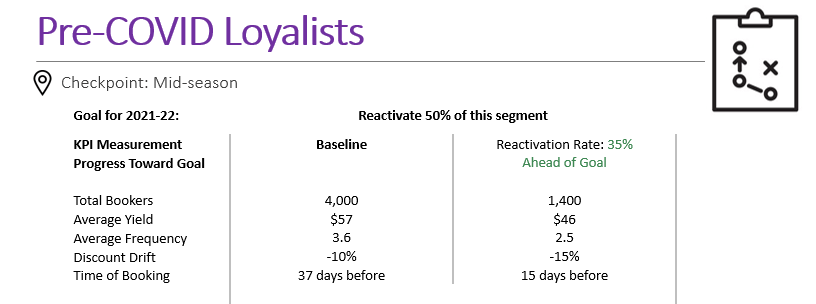
When we’re doing our planning there are basically three scenarios to plan for: ahead of goal, on track to meet goal, or behind my goal. In the above situation, we might be ahead of goal—as our pace is looking good to reactivate 50% of the segment—but the average yield is a bit lower than baseline and people are buying closer to the performance. So, we might roll out the following plays:

Let’s look at a different scenario, where we’re on track to meet goal:
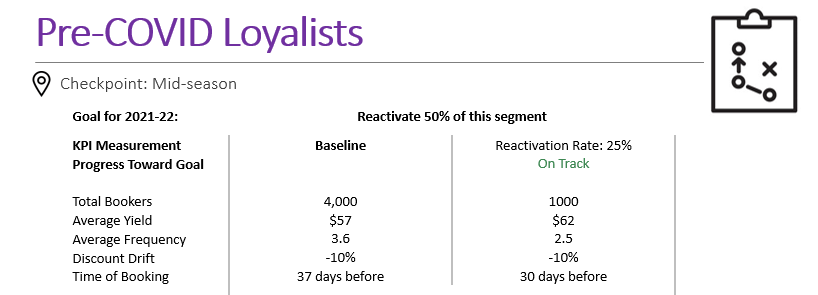
The plays for this scenario might look like this:

And finally, what do you do if the segment is behind pace to meet goal? Let’s look at this scenario:
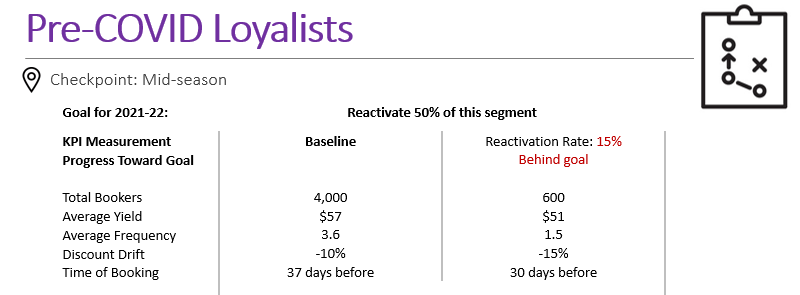
In this example, we’re getting a lower average yield than our baseline trends. This is typically my highest paying segment, and they’re paying less than usual, so it could be that there’s more price sensitivity in this group than there was before, and discounts might be a good incentive.

These are all just examples of the types of plays you might consider, but the point is that you should identify what levers are available to pull in various scenarios to steer you toward your goals and reengage your audience.
BRINGING YOUR PLAYBOOK TOGETHER
By using this framework and crafting your playbook, you’ll have a well-defined picture of the people in your audience, your goals to reengage them, and a plan to reach your goals. You’ll also be able to react quickly and refocus your efforts if you aren’t on course to meet segment goals.
This part of the Playbook related to segmentation is an excellent thing to prepare during the summer of 2021, but it’s only half of the Playbook. The other half looks at revenue management plays. Continue building your playbook with The Reopening Playbook: Pricing and Revenue Management.
NEED HELP WITH SEGMENTATION?
We’re here for you! Our segmentation consulting will prepare you to reengage all sectors of your audience and focus your marketing efforts where you can find the most success.
INDUSTRY INSIGHTS, DELIVERED DIRECTLY
Sign up for our JCA Arts Marketing newsletter to receive marketing insights, including advice for COVID-19 recovery and pricing best practices.
